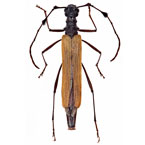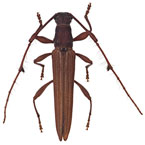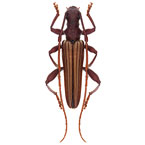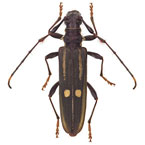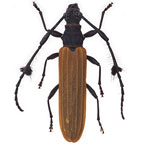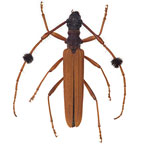Tropis
Newman
Cerambycinae
Tropis Newman, 1841: 34. Type species: Rhagiomorpha oculifera Newman, 1840.
Diagnosis
Small to medium-sized, slender beetles with male antennae often extending beyond apex of elytra. Frontoclypeus transverse. Eyes large, finely facetted, distinctly emarginate. Antennal insertions separated. Antennal foramen prominent. Antennal scape as long as pronotum, posteriorly extends beyond posterior margin of pronotum; pedicel slightly elongate; antennomere 3 shorter than scape, usually bearing tufts of black setae; antennomeres 4–7 without apical spines. Pronotum variable, lateral margins with angulate lateral projections or median pointed tubercle at middle; pronotal disc nodulose or tuberculate. Prosternal process narrow, slightly expanding apically. Procoxal cavities transverse with deep lateral extensions, protrochantin exposed; broadly open externally. Procoxae slightly projecting below prosternal process. Mesocoxal cavities widely separated medially, open to mesepimeron; mesotrochantin visible. Mesoventral intercoxal process broad, notched apically. Elytra complete, with 4 weak costae; elytral punctures indistinct, not in rows. Femora broadest near middle, hind femur not exceeding abdominal apex.
Distribution and Biology
Tropis is an Australian endemic and is widely distributed along the eastern and southern coastal areas of the continent from Rockhampton in Queensland to Victoria and South Australia, and reaching the Stirling Range National Park in Western Australia.
Several species with intense red colour on their elytra appear to be lycid mimics; they are found during the summer months on flowers of Angophora and Leptospermum. The largest and the least aposematic species, T. lepturoides, is attracted to freshly fallen logs of Eucalyptus globulus.
Australian Species
armata (Oke)
Tritocosmia armata Oke, 1932: 162.
exilis (Pascoe)
Rhagiomorpha exilis Pascoe, 1859: 58.
lepturoides (Boisduval)
Stenochorus lepturoides Boisduval, 1835: 479.
Rhagiomorpha sordida Newman, 1840: 21.
Physodroma sexcostata Thomson, 1860: 150.
Rhagiomorpha concolor Heyne & Taschenberg, 1906: pl. 36, fig. 12.
oculifera (Newman)
Rhagiomorpha oculifera Newman, 1840: 21.
paradoxa (Pascoe)
Tritocosmia paradoxa Pascoe, 1859: 56.
plagiata (Hope)
Rhagiomorpha plagiata Hope, 1842: 429.
roei (Hope)
Stenoderus roei Hope, 1834: 17.
rubea (Pascoe)
Tritocosmia rubea Pascoe, 1859: 24.
References
Boisduval, J.A. 1835. Voyage de Découvertes de l'Astrolabe exécuté par ordre du Roi, pendant les années 1826–1827–1828–1829, sous le commandement de M.J. Dumont d'Urville. Faune Entomologique de l'Océan Pacifique, avec l'illustration des insectes nouveaux recueillis pendant le voyage. 2me Partie. Coléoptères et autres Ordres. Paris : J. Tastu vii 716 pp.
Heyne, A. & Taschenberg, O. 1906. Die exotischen Käfer in Wort und Bild. Leipzig, Schreiber 1906 21/22: i-vii + 1–262 + I-L, 39 pls.
Hope, F.W. 1834. Descriptions of some hitherto uncharacterized exotic Coleoptera, chiefly from New Holland. Transactions of the Entomological Society of London 1(1): 11–20 pls i-ii.
Hope, F.W. 1842. Observations on the Coleoptera of Port Essington, in Australia. Annals and Magazine of Natural History 1 9: 423–430.
Newman, E. 1840. Nonnullorum Cerambycitum novorum, Novam Hollandiam et Insulam Van Diemen habitantium characteres. Annals of Natural History 1 5: 14–21.
Newman, E. 1841. Entomological notes (continued). The Entomologist 1(3): 33–37.
Oke, C. 1932. Notes on Australian Coleoptera with descriptions of new species. II. Proceedings of the Linnean Society of New South Wales 57: 148–172.
Pascoe, F.P. 1859. On new genera and species of longicorn Coleoptera. Part IV. Transactions of the Entomological Society of London n.s. 5(1): 12–16.
Thomson, J. 1860. Essai d'une classification de la famille des cérambycides et materiaux pour servir a une monographie de cette famille. Paris : J. Thomson 396 pp. + 3 pls.
